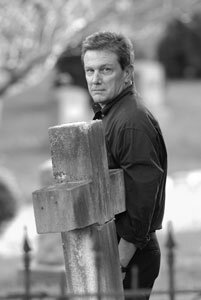FACETIME- Vampire volume: McClelland drinks in success
Forget bats. Forget looming spooky castles. Forget slicked-back black hair and a cape and any other image that comes to mind when you hear the word "vampire." According to Bruce McClelland, author of a new book, Slayers and their Vampires: A Cultural History of Killing the Dead, the modern perception of vampires is all wrong. And, as usual, he says, Hollywood is to blame.
"When people hear the word vampire, they usually picture something like Bela Lugosi in the role of Dracula," says McClelland, 57, referring to the 1931 film version of Bram Stoker's late-19th century novel, Dracula. Francis Ford Coppola's 1992 version starring Gary Oldman didn't help debunk the misconceptions.
While Stoker's novel is loosely based on a historic character from the 17th century, the brutal Romanian warlord Vlad the Impaler, McClelland says the vampire myth dates back at least 1,000 years to Slavic folklore about partying pagans.
The word vampire "had a lot to do with animal sacrifice," says McClelland. The Slavic word "pire," he says, "has to do with feasting and ritual libations." Ritual libations? Animal blood.
McClelland's interest in vampires– and in the myth of the vampire slayer– dates back 30 years, and, he admits, started with a fascination with Vlad. McClelland penned a book of verse dubbed Dracula Poems in 1978 before pursuing a master's in Russian Language and Literature at SUNY-Albany.
While living in Greenwich, Connecticut in the early '90s, McClelland read a book called The Darkling: A Treatise on Slavic Vampirism, by Jan Perkowski, a UVA professor. Corresponding with Perkowski whetted McClelland's thirst for vampires once again.
In 1993, McClelland and his wife, Cindy, now co-owner of downtown boutique Eloise, moved to Charlottesville where he began graduate study. But it was no straight shot to a degree. After a three-year break spent working in Moscow for an Internet nonprofit, McClelland at last earned his PhD in folklore at UVA in 1999.
His dissertation topic: "Sacrifice, Scapegoat, Vampire: On the Social and Religious Origins of the Bulgarian Folkloric Vampire." The dissertation forms two chapters of the book, but he spent countless hours poring over historic texts both here and in Bulgaria for further information on the vampire slayers, mythological figures McClelland says can be as frightening as the creatures they're trying to kill.
That Hollywood doesn't portray vampires accurately is understandable, he says, because most Hollywood types don't have access to 1,000-year-old source material.
"From the Balkan Mountains to Beverly Hills," according to Perkowski, "Bruce has mapped the vampire's migration. There's no better guide for the trek."
McClelland hopes his new book, published by the University of Michigan Press, will appeal to a wider audience than most works from academic presses– and may even change the image of vampires.
"The whole point," he says, "is to let people know there's a whole other history of vampires that's even more interesting and more useful."

Bruce McClelland
PHOTO BY JEN FARIELLO
#